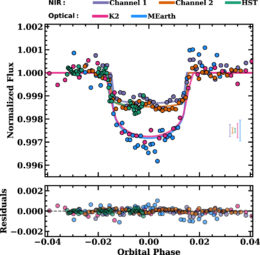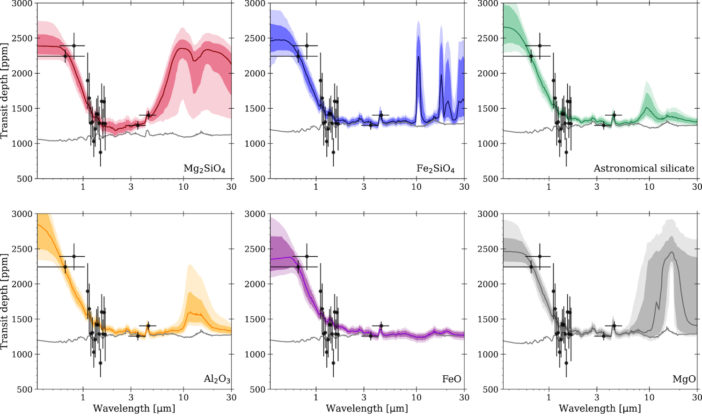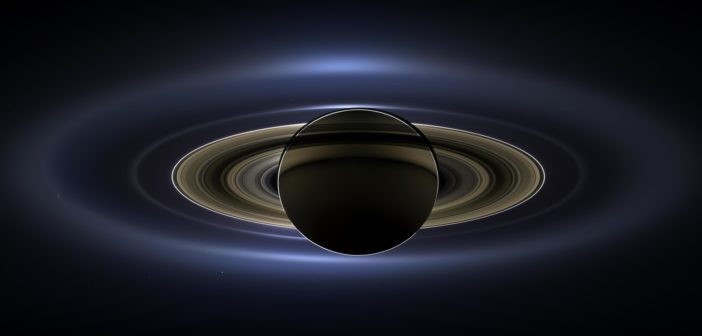Editor’s Note: Astrobites is a graduate-student-run organization that digests astrophysical literature for undergraduate students. As part of the partnership between the AAS and astrobites, we occasionally repost astrobites content here at AAS Nova. We hope you enjoy this post from astrobites; the original can be viewed at astrobites.org.
Title: A Circumplanetary Dust Ring May Explain the Extreme Spectral Slope of the 10 Myr Young Exoplanet K2-33b
Authors: Kazumasa Ohno et al.
First Author’s Institution: University of California, Santa Cruz
Status: Published in ApJL

Figure 1: Transit light curves of K2-33b using multiple instruments. The optical observations from K2 and MEarth show much deeper transits than those in the near-infrared observation, obtained with Spitzer IRAC’s Channels 1 and 2 and the Hubble Space Telescope. This could be because the planet’s atmosphere is blocking more light at bluer optical wavelengths than in the infrared. [Thao et al. 2022]
K2-33b is one such planet with a very steep slope (check out this astrobite to find out more!), with ground- and space-based observations showing much deeper transits at bluer wavelengths, as seen in Figure 1. In this case, the host star probably isn’t active enough induce the slope we see, so a hazy atmosphere around a puffy, low-density planet is thought to be the culprit. But what if there were another possible explanation? The authors of today’s article consider whether a ring of dust around K2-33b could be responsible.
Ringing Out the Details
Using the presence of exoplanetary rings to interpret seemingly inexplicable observations isn’t a new idea. Rings could explain why some seemingly low-density exoplanets have flat transmission spectra; since the presence of rings would increase the radius obtained from the transit method while the mass of the system remains the same, rings could lead us to believe a planet’s density is lower than it is. But if rings produce a flat spectrum, how could they explain what’s happening with K2-33b? The authors of today’s article explain that the opacity of the ring is essential (take a look at Figure 2 for a handy guide!).

Figure 2: An illustration of how the presence of rings and their opacities can impact the transmission spectrum of an exoplanet’s atmosphere. [Ohno et al. 2022]
Does the Right Ring Make a Good Match?
To check whether this explanation could work for the transmission spectrum of K2-33b, the authors model both the atmosphere of the planet and rings of different mineral compositions.
Figure 3 demonstrates that with the right opacity, rings of all compositions are able to match the observations, reproducing the steep slope caused by the deeper transits at blue wavelengths. By comparing the coloured models to a model without the presence of a ring, shown by the grey line in each panel, it’s clear that the addition of rings is a big improvement! Many of the ring compositions also produce distinctive absorption features in the mid-infrared, which, if present, could be identified with JWST’s Mid-Infrared Instrument and would help confirm the existence of a ring.

Figure 3: The transmission spectrum of K2-33b (black data points) along with models of the atmosphere without the presence of a ring (the flatter grey lines) and models including rings of different mineral compositions (coloured lines and shaded regions). Each panel highlights the impact of a ring made of a different mineral, as labelled in the bottom right of each panel. Note that the y axis shows the transit depth in parts per million (ppm), so a larger value here indicates less flux reaching the observer. [Ohno et al. 2022]
Original astrobite edited by Jessie Thwaites.
About the author, Lili Alderson:
Lili Alderson is a second-year PhD student at the University of Bristol studying exoplanet atmospheres with space-based telescopes. She spent her undergrad at the University of Southampton with a year in research at the Center for Astrophysics | Harvard-Smithsonian. When not thinking about exoplanets, Lili enjoys ballet, film, and baking.

